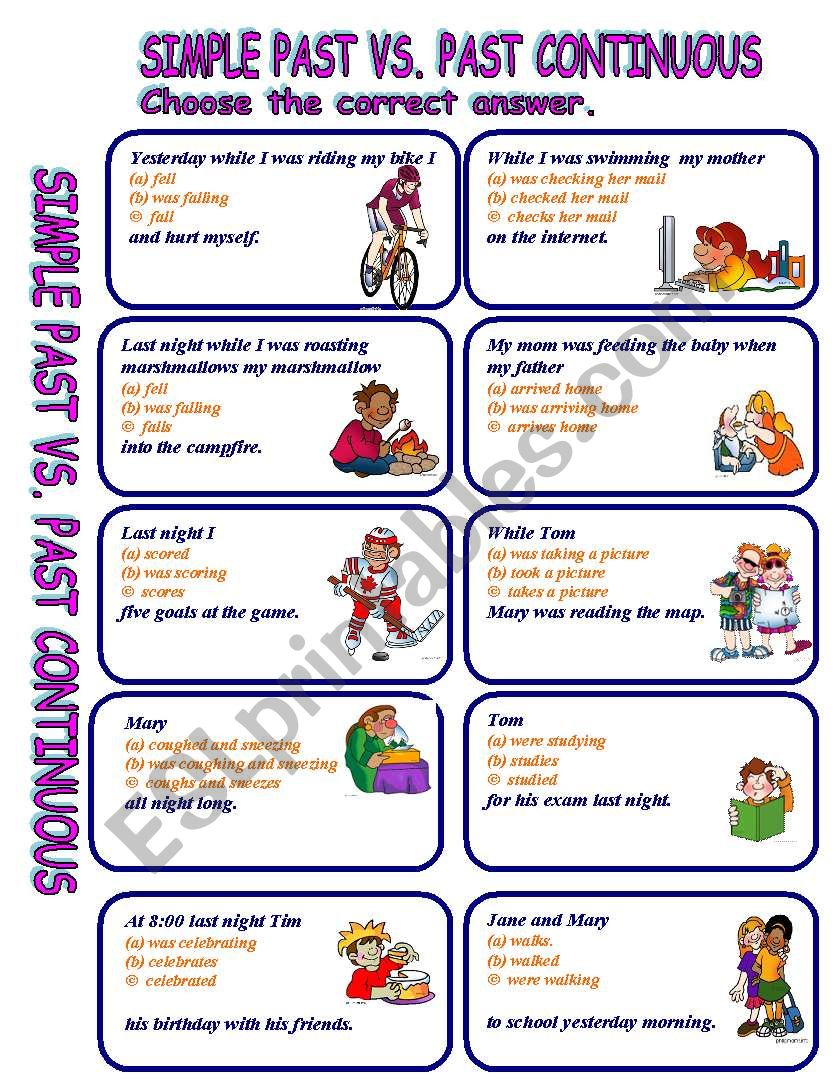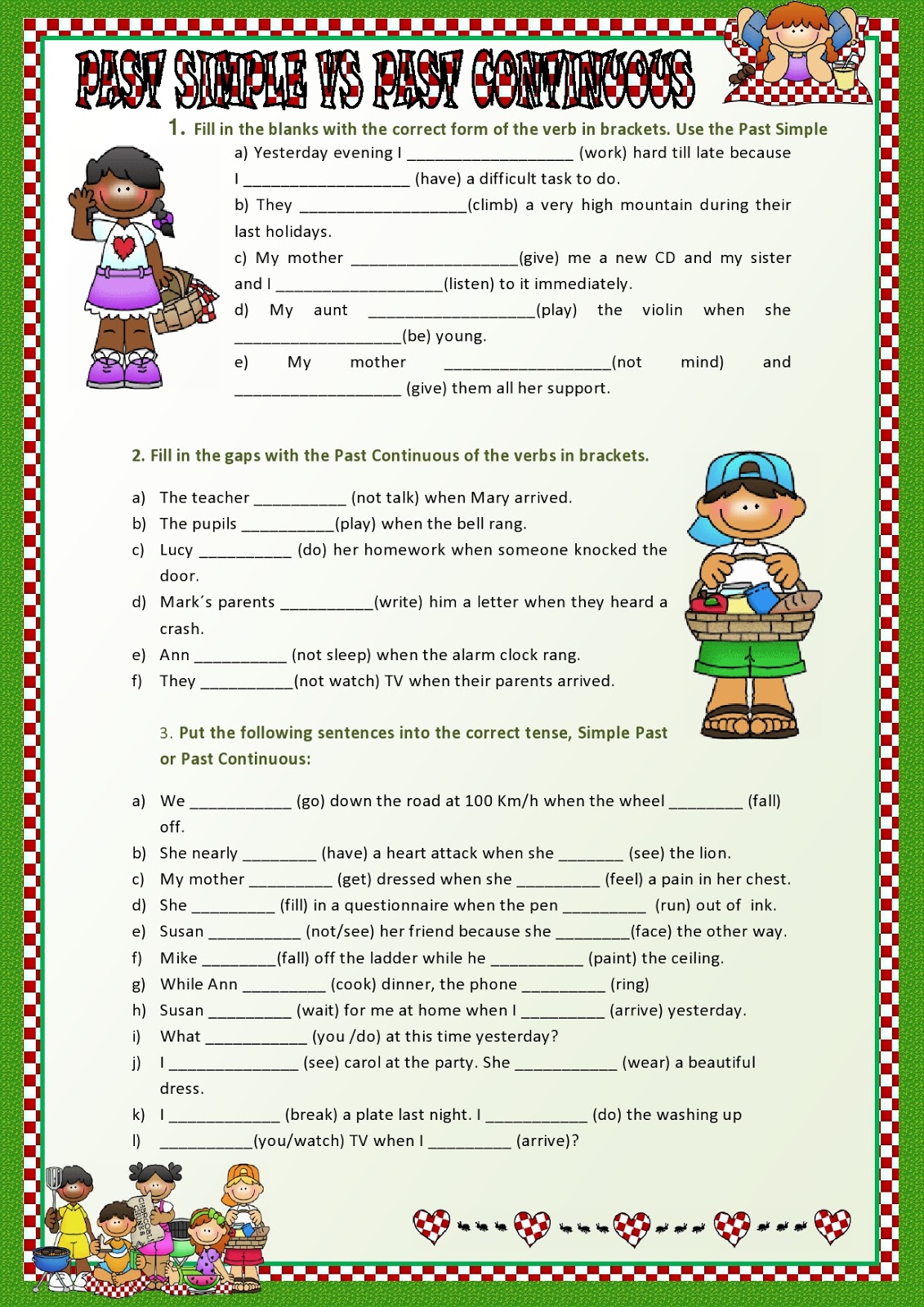Past Continuous Tense, Definition and Examples English Grammar Here
แบบฝึกหัด Past Continuous Tense และ Past Simple Tense เรียนรู้อย่างง่ายสำหรับผู้สนใจของภาษาอังกฤษ
To form the past continuous positive, use subject + (to be) + verb + -ing Examples: "What were you doing when I called you?" "I was studying." She was playing guitar at the party. At 5:30 last night, we were driving home. They saw a starfish while they were walking on the beach. Past Continuous Negative

Past Continuous Tense Definition, Examples, & Formula
f t p. The past continuous (also called past progressive) is a verb tense which is used to show that an ongoing past action was happening at a specific moment of interruption, or that two ongoing actions were happening at the same time. Read on for detailed descriptions, examples, and past continuous exercises.

Past Continuous Tense Examples EnglishTeachoo
Past tense simple and progressive 1. Past tense simple and progressive 2. Past simple / continuous - 1. Past simple / continuous - 2. Past simple / continuous - 3. Past simple / continuous / perfect pdf. Past simple vs continuous - pdf. Past simple vs progressive - pdf. Past simple / continuous: download and print.

Past Perfect Continuous Tense Worksheet with Answers EnglishGrammarSoft
The Past Continuous tense expresses action at a particular moment in the past. The action started before that moment but has not finished at that moment. For example, yesterday I watched a film on TV. The film started at 7pm and finished at 9pm.

Narrative tenses Grammar chart, English grammar, Learn english words
February 6, 2013 - The simple past and the past continuous are two tenses commonly used to make general statements about the past. Although they are both past tenses their uses are quite different. The simple past tense is only used to say that something happened at some time in the past. I went to a Chinese restaurant yesterday.

Frases Past Simple Y Past Continuous
The past continuous is made from the past tense of the verb be and the -ing form of a verb: We use the past continuous to talk about the past: for something which happened before and after another action: The children were doing their homework when I got home. Compare: The children did their homework when (= after) I got home.

Past Simple Tense vs Past Continuous Tense English Learn Site
Firstly, check that you know how to make the past simple with 'be' (subject + was / were). Then just add verb-ing. Click here to download this explanation as a pdf. Click here for practice on how to USE the past continuous. Here's the positive form: I was sleeping. you were working. he was coming. she was reading 'War and Peace'.

Past Continuous Tense Grammar Rules and Examples 7 E S L
Grammar test 1 Read the explanation to learn more. Grammar explanation The past continuous and the past simple help us to show how two past actions or situations are connected. Past simple The past simple shows us that an action was in the past, not in the present. Regular past simple verbs have - ed at the end (e.g. called, played, arrived ).

PAST SIMPLE AND PAST CONTINUOUS Past simple and past continuous, Past simple, Simple past tense
Exercise 1 Choose the correct past continuous and past simple forms to complete the sentences below. 1 I while I down the stairs. 2 He very fast when he the accident. 3 It when we home. 4 I your call because I . 5 This morning I and I breakfast for everybody. 6 When I her, she a really nice purple dress. 7 Last Saturday we late and we the train.

Past Continuous Tense (Formula, Usage, Examples) ExamPlanning
There are two tenses in English - past and present. The past tense in English is used: to talk about the past. to talk about hypotheses (when we imagine something) for politeness. There are four past tense forms in English: Past simple: I worked. Past continuous:

Past Continuous or Past Simple English grammar worksheets, English language learning, Teaching
Permalink. Hi yyyyyyyy7, "When" + past simple action 1 + past simple action 2 shows actions that are connected in the sense that action 1 leads smoothly into action 2. Action 2 follows very shortly after action 1. The focus of the sentence is on both actions. When I closed my eyes, I fell asleep.

A+ Excellent Practice Simple Past tense vs Past Continuous tense
Past continuous = I was working Past simple = I worked Choice of emphasis Often there is little difference between the past continuous and the past simple, except that the past continuous suggests that the event (s) were in progress at a time in the past or that they were happening as background or temporary events.

Past Perfect Simple and Continuous ChaseoiKent
Past Simple or Continuous? Past simple or progressive - 1 Negative sentences - exercises Past Simple and Continuous - 1 Past Simple and Continuous - 2 Past simple or past progressive Simple past or past progressive Simple past - past progressive Simple past / past continuous Past simple or progressive - 1 Past simple or progressive - 2
Past Simple & Continuous Test
The past continuous, or past progressive, tense describes an action or situation that began in the past and is still going on in the present time. The past continuous is easily formed by pairing up the verb to be' with a verb ending in -ed' instead of -ing' (e.g. was talking). The second section below has some great examples of how to use.

Past Simple and Past Continuous Interactive worksheet
Past Simple or Past Continuous Exercise 1 Perfect English Grammar Past Simple and Past Continuous Exercise 1 Here's an exercise to practise the verb tenses. Choose the past simple or past continuous tense. You can review how to use the past simple here and how to use the past continuous here.

Simple Past Tense Definition & Useful Examples in English ESL Grammar
The past continuous is usually used to refer to events happening at the same time that something important happened in the past. They were doing their homework when she arrived. Jack was studying while Dave was cooking dinner. The past continuous is also used to express what was happening at a precise moment in the past.